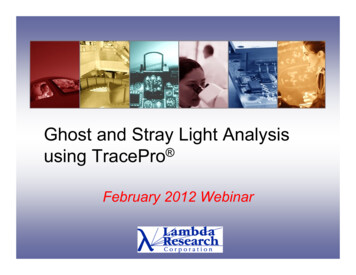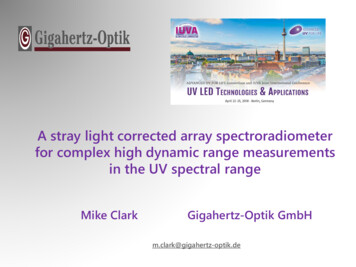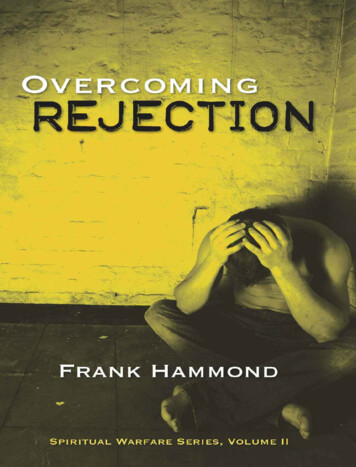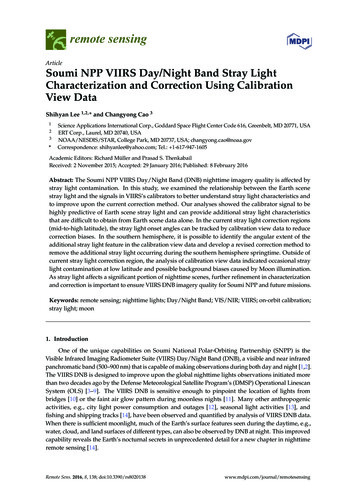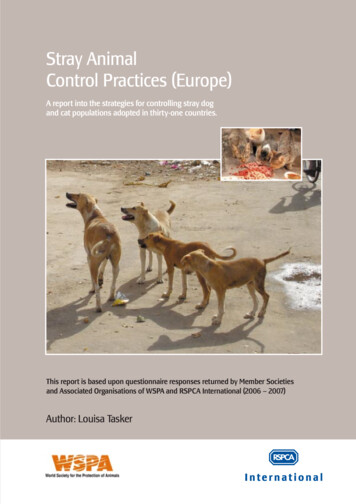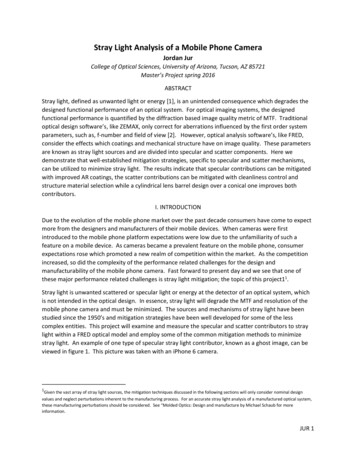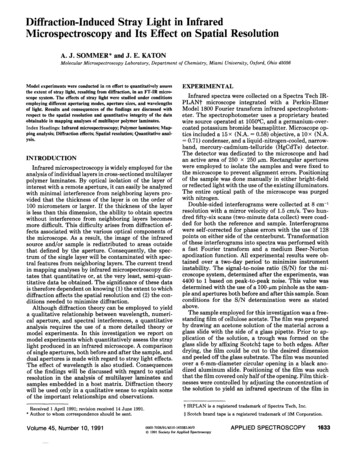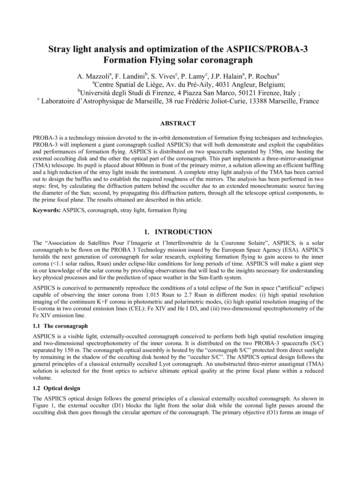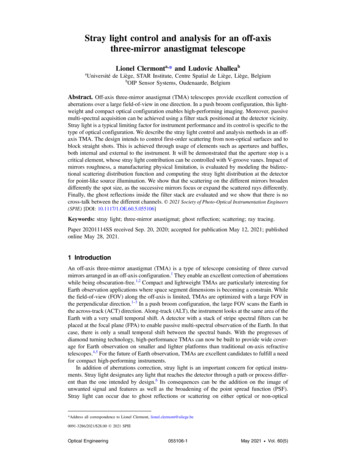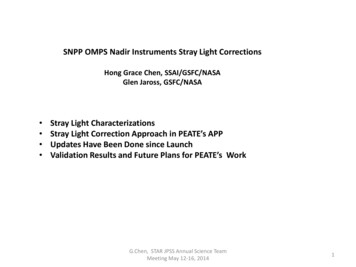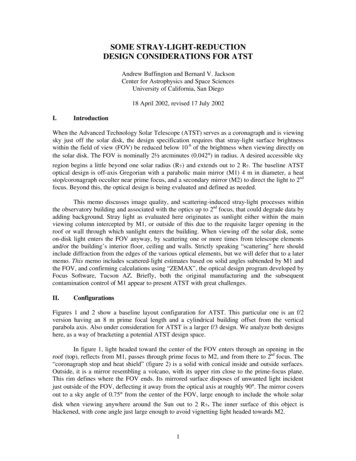
Transcription
Thursday, 05 June 2008Stray Light Rejection in ArraySpectrometersMike Shaw, Optical Technologies & Scientific Computing Team,National Physical Laboratory, Teddington, Middlesex, UK1
Thursday, 05 June 2008Overview Basic optical design of an array spectrometerIn system (heterochromatic) stray lightTechniques for quantifying stray light rejectionResults: stray light errors in some commercially availablespectrometers. Methods for reducing stray light errors Application of a modified array spectrometer: New NPL Goniospectroradiometer Some other important performance parameters for arrayspectrometers Conclusions and future work.2
Thursday, 05 June 2008Basic optical layout of an array ongratingDetectorarrayFocussingmirror3
Thursday, 05 June 2008In system (heterochromatic) stray light Often the dominant source of uncertainty in measurementsmade using compact array spectrometers.Rays strike the wrong part of the detector array causingspurious measured signals at the wrong wavelength.Distinguished from ambient (homochromatic) stray light.4
Thursday, 05 June 2008Causes of stray light errors in arrayspectrometersScattering fromoptical surfacesInterreflectionsbetween surfaces –particularlyreflections offdetector arrayInadequate blockingof other diffractedorders5
Thursday, 05 June 2008Stray light errors are source mlDeuteriumlamp 0450500550600Wavelength (nm) 65070075080Spectral Total Flux of a Tungsten Halogen Lamp0.030.0251.00E 036.00E-04Spectral Total Flux (arb. units)350Relative SPDof Four LEDs1.20E 03Spectral Total Flux (arb.units)450Spectral Irradiance (W/m 2/nm)Spectral Total Flux (arb. units)Spectral Total Flux of a Fluorescent Lamphttp://en.wikipedia.org/?title Light bulb8.00E 025.00E-04LED1LED26.00E 024.00E-043.00E-040.015LED3LED44.00E 022.00E-042.00E 021.00E-040.00E 002000.020.010.0050.00E ngth(nm)Wavelength h (nm)Stray light errors tend to be most critical whenmeasuring a broadband spectrum with an intensityvarying over several orders of magnitude.680
Thursday, 05 June 2008Dark Corrected measured signal (normalisedto max)Stray light signal observed using a laser line1.E 001.E-01Background due toheterochromaticstray light1.E-02Measured SpectraIdeal xel no.These results could be used to state that straylight rejection is 10-5 some distance away fromthe centre wavelength of the laser line. Howeverthis does not tell us what errors to expect whenmeasuring a broadband light source.7
Thursday, 05 June 2008Stray light errors for an incandescent sourceSpectral Total Flux of a Tungsten Halogen Lam p0.03Spectral Total Flux (arb. 070075080W avelength (nm )Relatively low spectralflux at shorter visibleand UV wavelengthsRelatively high spectralflux at longer visibleand NIR wavelengths8
Thursday, 05 June 2008Stray light errors for an incandescent sourceS p e c t r a l T o t a l F lu x o f a T u n g s t e n H a lo g e n L a m p0 .0 3Spectral Total Flux (arb. units)0 .0 2 50 .0 20 .0 1 50 .0 10 .0 0 5035040045050055060065070075080W a v e le n g t h ( n m )Small fraction of radiation inside thespectrometer is measured asheterochromatic stray light9
Thursday, 05 June 2008Stray light errors for broadband light sourcesProblem is often exacerbated by spectral responsivity ofdetector array.e.g. Spectral responsivity of a silicon based detectors tends tobe higher at longer wavelengths.10
Thursday, 05 June 2008Quantifying stray light errorsMeasurement oflamp signal,Vlamp(λ)Fibre input to spectrometerBackground corrected Signal Measured from a QuartzTungsten LampG. R. Hopkinson, T. M. Goodman and S. R. Prince, “A guideto the use and calibration of detector array equipment (SPIEPress Book),” SPIE (2004).Background correctedsignal (counts)1.E 071.E 061.E 051.E 041.E 03300400500600700800Wavelength (nm)11
Thursday, 05 June 2008Quantifying stray light errorsMeasurement throughcut on filter, Vfilter(λ)Fibre input to spectrometerBackground corrected Signal Measured from a QuartzTungsten Lamp Through a GG435 cut on FilterNominal transmittance of GG435 (3mmthickness) cut on filterTransmittance (%)1.E kground correctedsignal (counts)1.E 071.E 061.E 051.E 041.E 031.E-03300400500600700800Wavelength (nm)1.E-04Wavelength (nm)12
Thursday, 05 June 2008Quantifying stray light errorsShutter to block light sourcefrom spectrometer field of viewFibre input to spectrometerBackground SignalMeasurementof backgroundsignal, Vbg(λ)signal (counts)1.E 071.E 061.E 051.E 041.E 03300350400450500550600650700750800Wavelength (nm)13
Thursday, 05 June 2008Analysis of stray light data For an ideal spectrometer: T filter (λ ) Vlamp (λ ) Vbg (λ )Transmittance of GG435 glass filter (3mmthickness)100%90%Transmittance (%)Stray light signals causedeviations from idealbehaviour and indicateerroneously high filtertransmittance atwavelengths shorter thanthe cut on.V filter (λ ) Vbg (λ )80%70%60%50%30%Measured usingarray 0540580Wavelength (nm)Stray light errorof 90%!14
Thursday, 05 June 2008Comparison of Different Array DetectorsThe cut on filter method provides a way to compare theperformance of different array spectrometers for measuring thespectral irradiance from a broadband light source.Transmittance of GG435 measured using a quartz Tungsten lamp anddifferent array detectors100%Measured transmittance (%) spectrometer ASpectrometer BSpectrometer CSpectrometer E10%Spectrometer FSpectrometer GSpectrometer HGG435 Nominal1%200300400500600700800900Wavelength (nm)15
Thursday, 05 June 2008How to handle stray light? Live with itDetermine stray light contributionto measurement uncertainty. Correct for it Minimise the effect of straylight by calibrating thedetector under conditions asclose as possible to thoseunder which it will be used. Reduce itSpectral Total Flux of a Tungsten Halogen Lamp0.03Spectral Total Flux (arb. units)0.025 Match the F/# of input beamto F/# of spectrometer.0.020.0150.01 Stray light errors are toolarge for many avelength (nm)16
Thursday, 05 June 2008How to handle stray light? Live with it Correct for it Reduce itCharacterise the stray lightrejection of the instrumentand then correct for it.Spectrum of HeNe Laser Measured Using ArraySpectrometerInput laser radiation at different wavelengthsinto the array spectrometer to determineamount scattered onto each pixel as afunction of wavelength – stray lightcontribution to detector responsivity.Dark Correctedmeasured signal(normalised to max)1.E 01000Pixel no. S. W. Brown, B. C. Johnson, M. E. Feinholz, M. A. Yarbrough, S. J. Flora, K. R. Lykke, and D. K. Clark,“Stray light correction algorithm for spectrographs”, Metrologia 40, S81-83 (2003). Y. Zong, S. W. Brown, B. C. Johnson, K. R. Lykke, and Y. Ohno, “Simple spectral stray light correctionmethod for array spectroradiometers”, Applied Optics, Vol 45 No. 6, 20 Feb 2006.17
Thursday, 05 June 2008How to handle stray light? Live with it Correct for it Reduce itLimitations: This approach can be timeconsuming and expensive as itrequires the use of laser radiationover a large wavelength band. The resulting correction may also besensitive to changes in thespectrometer.Derive a spectral stray light correctionmatrix which can be applied to futuremeasurements made with thespectrometer.Ymeas [ I D]YIB AYIBYIB A 1YmeasHas been shown to reducesome stray light errors by 1-2orders of magnitude.18
Thursday, 05 June 2008How to handle stray light? Live with it Correct for it Reduce itUse additional baffles insidespectrometer to blockinterreflections – difficult toimplement and manydetectors are sealed.Use stray light blocking filters tolimit the wavelengths of lightreaching the detector array19
Thursday, 05 June 2008Stray Light Blocking Filters Reduce the bandwidth of radiation reaching thespectrometer using bandpass filters.Spectral Total Flux of a Tungsten Halogen Lamp0.030.025Spectral Total Flux (arb. units)Measure the spectrum over areduced wavelength rangewithout influence from straylight caused by scattering ofother 5070075080Wavelength (nm)20
Thursday, 05 June 2008Application of stray light blocking filters:NPL Goniospectroradiometer An instrument to measurethe spectral radiant intensitydistribution, Ie(λ, C, γ), of lightsources. Spectral and luminous flux,chromaticity, CCT etc.derived from Ie(λ, C, γ) Array spectrometer usedprimarily for speed of dataacquisition and compact size.Shaw M J, Goodman T M, “Array basedgoniospectroradiometer for measurement of spectralradiant intensity and spectral total flux of lightsources”, Applied Optics, vol 47 No. 13, 01 May 2008.21
Thursday, 05 June 2008Implementation of stray light blocking filtersapproach at NPLEstimatedStray LightErrorsofThroughFour TheoreticalStray esFour nce(%) signalStray light signal/ total measuredUse data from cuton filtermeasurements toestimate stray lightlevel throughtheoretical filters.100.0%filter 1filter 2filter 3filter 4no filter80%70%10.0%60%50%Filter 1Filter 2Filter 3Filter ngth (nm)500700700800800Wavelength (nm)22
Thursday, 05 June 2008Choice of stray light blocking filtersLook at effect of filter FWHM and CWL on predicted stray light errorGaussian Transmittance Profiles of Four Theoretical Blocking Filters100%90%Transmittance (%)80%70%Filter 1Filter 2Filter 3Filter 460%50%40%30%20%10%0%300400500600Wavelength (nm)700800Theoretical filters with Gaussian transmittance23
Thursday, 05 June 2008Real blocking filtersMeasured Transmittance of Four Real Blocking Filter Combinations100%90%Transmittance (%)80%70%60%T Filter 1T Filter 2T Filter 3T Filter 450%40%30%20%10%0%300400500600700800Wavelength (nm)Blocking filters fitted into filter wheel behindspectrograph entrance slit24
Thursday, 05 June 2008Stray light tests using blocking filtersTransmittance of GG435 (3mm) Measured Without Blocking Filters100%90%80%Transmittance (%)70%60%Nominal50%40%30%No blocking elength (nm)25
Thursday, 05 June 2008Stray light tests using blocking filtersTransmittance of GG435 (3mm) Measured With Blocking FiltersSignificant100%reduction instray light signalsat short90%wavelengths.80%Transmittance l0%-10%35040045050055060065070075080Wavelength (nm)Increased noise at shorter wavelengths.26
Thursday, 05 June 2008Limitations of using stray light blocking filters Increased measurement time. If using N blocking filters in afilter wheel then N different exposures are necessary time tomove filter wheel. Slightly reduced detector sensitivity (not significant if filtersare well chosen). Temperature effects (need to be aware of temperaturesensitivity of filter transmittance).27
Thursday, 05 June 2008Implementation of stray light blocking filters Another implementation of the blocking filters is to coat themonto corresponding areas of the detector array, effectivelyblinding each pixel to radiation at wavelengths other than thosewhich it ‘should’ see. Introducing another optical component into the system willchange its overall stray light characteristics.Model the optical system with the filtersto determine their effect.28
Thursday, 05 June 2008Results – compact fluorescent lampLuminous intensitydistribution29
Thursday, 05 June 2008Results – compact fluorescent lampSpectral total fluxScatter plot of chromaticitycoordinates30
Thursday, 05 June 2008Results - white LED clusterSpatially varying correlatedcolour temperature andchromaticity31
Thursday, 05 June 2008Some other important performancecharacteristics of array spectrometers Wavelength accuracySpectral resolutionLinearity(Spectral) responsivityThere are also many otherimportant performance parametersto consider, including those relatingto the detector array itself such asuniformity, well capacity, noise, etc.Apparatus for measurement ofdetector linearity.32
Thursday, 05 June 2008Conclusions Array spectrometers often suffer from poor stray light rejectionwhich can make them unsuitable for applications requiring a lowmeasurement uncertainty. NPL have modified an array spectrometer to incorporate aseries of custom designed stray light blocking filters. Thisinstrument has been used to measure the spectral and spatialoutput characteristics of a variety of different light sources.33
Thursday, 05 June 2008Future work Better understanding of uncertainties arising from stray lighterrors. Investigate use of stray light blocking filters further into the UV. Investigation into feasibility of monochromator based SLcorrection measurements at NPL.34
Thursday, 05 June 2008Acknowledgements Thanks to colleagues in the optical technologies andscientific computing team at NPL and TeresaGoodman in particular for her help and advice.35
Thursday, 05 June 2008Questions?Mike Shaw, Optical Technologies & Scientific Computing Team,National Physical Laboratory, Teddington, Middlesex, UKTel. 02089436646Email. mike.shaw@npl.co.uk36
Estimated Fractional Stray Light Errors Through Four Theoretical Stray Light Blocking Filters 0.1% 1.0% 10.0% 100.0% 300 400 500 600 700 800 Wavelength (nm) Stray light signal / total meas
